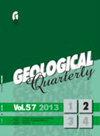阿尔及利亚西北部塔夫纳盆地浊积岩中晚新近世震积岩记录
IF 0.7
4区 地球科学
Q3 GEOLOGY
引用次数: 0
摘要
在同一时代的沉积物中发育的各种各样的软沉积变形构造(SSDS)可能会阻碍其起源的解释。有些类型的ssd可能看起来很相似,但有不同的触发机制,而其他类型的ssd可能是由特定的机制引起的。此外,特定固态硬盘的发展可能受到几个同步或半同步因素的影响。本研究从矿床的岩性和变形特征出发,探讨了SSDS的触发机制。新近纪晚期hajret El Gat地区(Tafna盆地)浊积岩沉积中存在不同类型的SSDS,主要与(1)斜坡作用(如滑塌褶皱)和诱导上覆压力,以及破碎层和超载构造相结合;(2)液化和流化现象相结合,导致了荷载构造、球枕构造、泄水构造和同沉积断裂的发育。研究区这两种SSDS形成机制被认为是地震诱发的结果。识别出垂直重复的、三明治状的变形层和未变形层排列以及SSDS特征(“被困”在层内)表明,这些内部变形的层是震积岩,这是在阿尔及利亚西北部的塔夫纳盆地首次发现的。大地震可能引发能量足够大的地震波,使地层变形并诱发SSDS的发展。这一假设得到了构造证据的支持,因为塔夫纳盆地地层沉积在非洲和欧亚大陆之间的辐合带,活动于晚新近纪。本文章由计算机程序翻译,如有差异,请以英文原文为准。
Record of Late Neogene seismites in turbidite deposits of the Tafna Basin (NW Algeria)
The wide variety of soft-sediment deformation structures (SSDS) developed within deposits of the same age may hinder the interpretation of their origin. Some types of SSDS may appear similar though have different trigger mechanisms, while others may result from a specific mechanism. Furthermore, the development of particular SSDS may be influenced by several synchronous or semi-synchronous factors. This study deals with the recognition of SSDS trigger mechanisms with respect to lithological and deformational features of the deposits concerned. Turbidite deposits of late Neogene age in the Hadjret El Gat area (Tafna Basin) contain different types of SSDS associated with (1) slope processes (e.g., slump folds) and induced overburden pressure, coupled with broken beds and overloading structures, and (2) liquefaction and fluidisation phenomena, leading to the development of load structures, ball-and-pillow structures, water-escape structures and syndepositional faults. These two mechanisms of SSDS formation in the study area are thought to result from seismically-induced triggers. Recognition of a vertically-repeated, sandwich-like arrangement of deformed and undeformed layers along with the SSDS features ("trapped" within beds) suggests that these internally-deformed beds are seismites, the first recognized in the Tafna Basin of NW Algeria. Large earthquakes may trigger seismic waves energetic enough to deform strata and induce the development of SSDS. This hypothesis is supported here by tectonic evidence, given deposition of the Tafna Basin strata in the convergence zone between Africa and Eurasia, active since the late Neogene.
求助全文
通过发布文献求助,成功后即可免费获取论文全文。
去求助
来源期刊

Geological Quarterly
地学-地质学
CiteScore
2.20
自引率
0.00%
发文量
19
审稿时长
>12 weeks
期刊介绍:
The policy of the Geological Quarterly is to publish significant contributions of information and geological insight relevant to an international readership. The journal has been issued since 1957 at the Polish Geological Institute - National Research Institute and, at present, is the leading Earth sciences journal in Poland. All aspects of Earth and related sciences, and universal and broad regional rather than locally oriented topics are covered.
The journal is intended to be an international forum for the exchange of information and ideas, particularly on important geological topics of Central Europe.
 求助内容:
求助内容: 应助结果提醒方式:
应助结果提醒方式:


